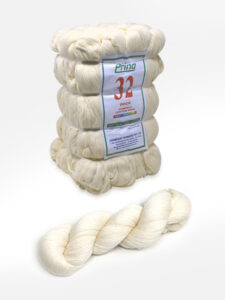What is Yarn Count? is an indirect method of measuring yarn thickness. Unlike solid materials, yarn is highly compressible, making thickness an unreliable measurement. Instead, weight per unit length serves as an indirect metric. In textile measurement:
- One hank = 840 yards
- If one hank weighs one pound, it is labeled as 1 count (Ne)
- If Ne × 840 yards = one pound, then the yarn is labeled as Ne count
The “e” in “Ne” stands for English count, distinguishing it from other systems like Denier (for synthetic fibers) and French Count.

Importance of yarn strength in weaving
Maintaining a consistent yarn count ensures fabric quality. Two key parameters to measure yarn uniformity are:
- Count Coefficient of Variation (Count CV): Lower variation = smoother fabric
- Uster Percentage (U%): Lower U% = fewer defects, ensuring high-quality output
- Yarn length uniformity: Directly affects the quality of weaving and fabric performance
Best yarn thickness for textile manufacturing
Several factors influence yarn performance:
- Twist Multiplier: Higher twist = stronger yarn; Lower twist = softer yarn (used for innerwear, T-shirts, etc.)
- Twist Max (T max): Beyond this point, added twist reduces strength
- Cotton Fiber Properties: Fiber length, fineness, and strength impact durability
- Breaks per Million Meters (BPM): A crucial parameter in warping; BPM below 0.5 is a good benchmark
- Weft Breaks: Affect weaving efficiency and productivity
- Yarn length consistency: Ensures smoother knitting and weaving processes
Impact on Fabric Quality
Cotton fiber properties influence fabric appearance:
- Reflectance (Rd) & Yellowness (+b): Determine brightness and shade uniformity
- Micronnaire Control: Prevents dyeing defects such as barre effects
- Combed vs. Carded Yarn: Combed yarn is superior, but carded compact yarns offer an alternative with reduced hairiness and better performance
- Yarn length precision: Helps in avoiding fabric inconsistencies and ensures durability
Choosing the Right Yarn for Your Fabric
Yarn selection depends on:
- GSM (Grams per Square Meter) and Cover Factor (warp & weft density)
- Finer yarns increase fabric density, improving texture and durability
- Multi-fold yarns enhance strength and aesthetics
- Yarn length accuracy: A critical factor in selecting the right yarn for a particular fabric type
Key Quality Measures in Yarn Production
To maintain high-quality standards, manufacturers monitor:
- Neps, Thin Places, Thick Places (Yarn Imperfection Index – IPI)
- AI-powered contamination control to eliminate foreign particles early in processing
- Yarn length consistency to prevent defects and ensure uniform production
Commercial Considerations in Yarn Production
- Moisture Content: Impacts weight and cost efficiency
- Length Uniformity: Reduces waste and maximizes yield
- Count Monitoring: Prevents losses due to variations in weight and thickness
- Yarn length measurement: Helps in determining production efficiency and optimizing resources
Industry-standard sources for yarn count measurement
Advancements in Yarn Technology
- Ring-Spun vs. Open-End Yarns: Ring-spun offers superior quality but is costlier
- Knotless Yarns: Achieved through splicers, improving efficiency
- Electronic Yarn Clearers (EYC): Uster & Loepfe’s AI-driven systems optimize quality, enabling loom speeds of 1,200+ RPM
Enhance Your Textile Production with High-Quality Yarns
By understanding yarn count and its impact on fabric quality, manufacturers can improve efficiency, reduce defects, and increase profitability.





